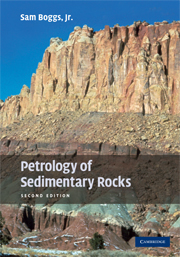Book contents
- Frontmatter
- Contents
- Preface
- Part I Principles
- Chapter 1 Origin, classification, and occurrence of sedimentary rocks
- Part II Siliciclastic sedimentary rocks
- Part III Carbonate sedimentary rocks
- Part IV Other chemical/biochemical sedimentary rocks and carbonaceous sedimentary rocks
- References
- Index
- References
Chapter 1 - Origin, classification, and occurrence of sedimentary rocks
from Part I - Principles
Published online by Cambridge University Press: 05 June 2012
- Frontmatter
- Contents
- Preface
- Part I Principles
- Chapter 1 Origin, classification, and occurrence of sedimentary rocks
- Part II Siliciclastic sedimentary rocks
- Part III Carbonate sedimentary rocks
- Part IV Other chemical/biochemical sedimentary rocks and carbonaceous sedimentary rocks
- References
- Index
- References
Summary
Introduction
Sedimentary rocks form at low temperatures and pressures at the surface of Earth owing to deposition by water, wind, or ice. By contrast, igneous and metamorphic rocks form mainly below Earth's surface where temperatures and pressures may be orders of magnitude higher than those at the surface, although volcanic rocks eventually cool at the surface. These fundamental differences in the origin of rocks lead to differences in physical and chemical characteristics that distinguish one kind of rock from another. Sedimentary rocks are characterized particularly by the presence of layers, although layers are also present in some volcanic and metamorphic rocks, and by distinctive textures and structures. Many sedimentary rocks are also distinguished from igneous and metamorphic rocks by their mineral and chemical compositions and fossil content.
Sedimentary rocks cover roughly three-fourths of Earth's surface. They have special genetic significance because their textures, structures, composition, and fossil content reveal the nature of past surface environments and life forms on Earth. Thus, they provide our only available clues to evolution of Earth's landscapes and life forms through time. These characteristics of sedimentary rocks are in themselves reason enough to study sedimentary rocks. In addition, many sedimentary rocks contain minerals and fossil fuels that have economic significance. Petroleum, natural gas, coal, salt, phosphorus, sulfur, iron and other metallic ores, and uranium are examples of some of the extremely important economic products that occur in sedimentary rocks.
- Type
- Chapter
- Information
- Petrology of Sedimentary Rocks , pp. 3 - 18Publisher: Cambridge University PressPrint publication year: 2009
References
- 1
- Cited by



